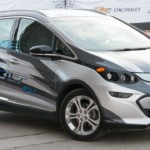Good question (thanks me), the answer to that really depends on how you feel about driving at night and how much night driving you do. While some drivers don’t have much of an issue with driving at night, at least half of drivers do feel anxious or nervous when it comes to driving on unfamiliar roads at night, or on unlit roads in general, based on a British survey. Ford’s new GPS-based headlights are one potential solution to easing that anxiety and providing drivers with better visibility at night.
And let’s be honest: that’s the whole point of having headlights in the first place. Well, they’re there to help you be more visible to other drivers at night, of course, but largely their purpose is to let you see the road and area ahead of your vehicle while driving. The more powerful headlights that we have today compared to several decades ago certainly help with that, but there are still some inherent limitations in what throwing more light at the problem can do. The GPS-based headlights being developed at Ford seek to surpass those limitations by letting your vehicle be smarter about how the road is actually lit up.
The Idea Behind It
Sometimes new inventions and innovations come to light (wordplay!) because of a “eureka” moment or a sudden instant of inspiration. More often, however, the inventions and new devices we use every day come to exist as a solution to a problem. In this case, the problem is the inherent flaw in most headlight systems on vehicles.
Your headlights are positioned on the front-end of your car, obviously, and they shine light out ahead of you to give you a better look at the road and surroundings in front of your vehicle. But when you’re driving during the day, with good weather, you’re not just looking at a small cone right in front of your vehicle (or at least you shouldn’t be). Your eyes are looking right in front of you, of course, but you’re also scanning your surroundings: glancing in your rearview and side mirrors to see what’s going on behind you, watching cars up ahead that are in other lanes, and looking at what the road is doing.
This last point is really the problem that Ford’s new GPS-based headlights seek to solve. When you’re driving at night, especially on unlit roads with only your headlights to provide illumination, you can’t see much beyond that bit of light directly in front of you. As you approach a turn in the road, for example, your lights are only illuminating a small area directly in front of you, giving you very little visibility for the shoulders and what’s coming up as the road bends. But not anymore.

How Ford’s GPS-Based Headlights Work
In the past, Ford has worked on headlights that use road signs and lane markings to adjust your headlights to illuminate the road better. They’ve gone beyond simply having your headlights react to these kinds of markers, however, and their new GPS-based headlights are able to adjust in a proactive or predictive way based on known road information. That’s where the “GPS” comes into play.
Basically, your vehicle will use GPS to keep track of your location, along with navigational information like you’d use to get directions. With this data, plus various calculations and simulation information, your vehicle will essentially know what the road is going to do up ahead, even if you can’t see it. So while you’re driving along, looking at the road as best you can, your vehicle would know that there’s a turn coming up ahead.
With this information, your car would automatically adjust your headlights to illuminate the area better when you approach a turn, curve, or similar change in the road. In one example that was shown based on the system they’re working on, extra illumination was provided for a turn so the driver could see what the road was doing and have a much better view of where they were heading. This would, in theory, alleviate stress and anxiety about night driving because you’d have a clearer view of the road ahead and not be surprised by anything in the darkness.
Is This Actually Helpful?
So far, based on the testing and the demonstrations that Ford has shown, I’d say this is definitely a concept that could help a lot of people. All else being equal, the primary difference between driving during the day and driving at night is visibility – you can see so much less at night, especially on a road without street lights, that the lack of visibility can be shocking. For a lot of people, the fear of the unknown is a huge source of anxiety and worry – and if you can’t clearly see where the two-ton machine you’re in control of is going, the unknown is definitely disconcerting.
Ford’s new GPS-based headlights look like a really interesting solution to the problem of night-driving visibility, and I think they could work incredibly well. To me, however, the solution is ultimately going to be a combination of things. For example, I’ve seen some auto companies start to utilize night vision and thermal imaging technology with their cameras. This way, when you’re driving at night, you can look at one of the displays in the car to see the road ahead using night vision, with sources of heat, like pedestrians or animals, highlighted on the screen.
I think combining these different technologies, with some improvements, will really change the way people drive at night and make a lot of us more comfortable getting behind the wheel after the sun has gone down. Imagine driving on an unlit road, knowing that your headlights will adjust automatically when you approach a curve to give you a better view of your surroundings. Now imagine adding a head-up display that uses augmented reality and night vision information to highlight sources of heat on your windshield in real-time. So as you’re driving, you’ll see a box or outline in color on your windshield warning you that a large deer is approaching the side of the road.

What Do You Need to Know as a Car Buyer?
Sounds pretty good, right? Unfortunately, the situation I just described is not something you’re going to find in a vehicle just yet. These separate systems are all being worked on and getting really close to being ready, but I don’t know of a company combining all of them into a single system for a vehicle. I wouldn’t be surprised to see it happen in the not-too-distant future, but it’s not something you’ll find right now.
So if you’re shopping for a vehicle in the next month or so, something like Ford’s new GPS-based headlight system really isn’t something you need to have in mind. This is still in testing and development, with no word on when it will be available on any of their vehicles. But in the years ahead, this is something you’ll probably find at Ford dealerships – likely on their high-end trims at first – and that will eventually become more common, perhaps even standard. It helps to know about these systems and keep them in mind so that when you go shopping for a car a decade from now, you’ll know what to expect.


